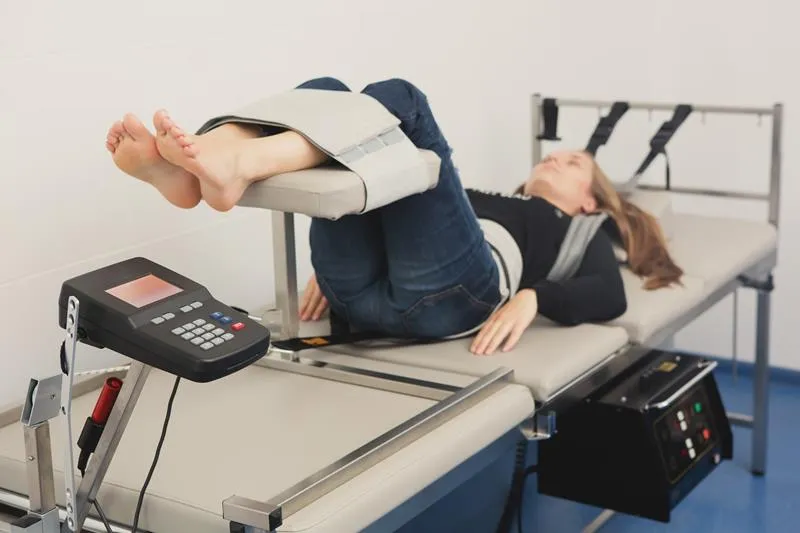What Are the Pros and Cons of Spinal Decompression Therapy?


Chronic back and neck pain affects millions of people, often due to conditions like herniated discs, degenerative disc disease, sciatica, or nerve compression. When massage, chiropractic care, physical therapy, or medication don’t provide lasting relief, spinal decompression therapy has become a popular non-surgical option. This treatment—available in both non-surgical and surgical forms—offers meaningful help for many, but it’s important to understand both the benefits and limitations before starting therapy.
Spinal decompression therapy targets the pressure on the spinal discs—the soft cushions between your vertebrae that absorb shock and allow movement. There are two main types:
NSDT is typically delivered over 10–15 sessions in 6–8 weeks, with each session lasting about 30 minutes. Advanced equipment, like the MT Core used at ReWin Therapy, adjusts resistance based on real-time feedback for comfort and precision. Patients usually describe the process as a relaxing stretch, although some temporary soreness or fatigue can occur post-session.
Spinal decompression is considered by many chiropractors and physical therapists a powerful, noninvasive way to manage chronic back and neck pain. Here’s why it’s becoming so popular.
Unlike surgery, NSDT requires no anesthesia, incisions, or hospital stays. It’s a non-invasive, drug-free treatment, so there’s no risk of reactions to anesthesia, infections, or complications from painkillers. Most people can return to daily activities right after a session.
Several randomized controlled trials have demonstrated significant improvements in pain, mobility, and quality of life for people with herniated or degenerative discs, especially when combined with physiotherapy. For example, research published in BMC Musculoskeletal Disorders found patients receiving NSDT plus physiotherapy experienced greater pain reduction and functional improvement compared to physiotherapy alone. An International Journal of Clinical Practice study even showed measurable reduction in herniated disc volume on MRI after NSDT, highlighting structural improvements.
By restoring disc height and increasing blood flow, spinal decompression nourishes injured tissues and speeds up healing. Many patients notice better posture, less stiffness, and improved mobility after completing their treatment plan.
While everyone responds differently, many people feel relief after just a few sessions. Because the therapy directly targets disc pressure, results can come faster than with general exercise or manual therapies alone.
There’s no healing period, stitches, or downtime after NSDT. Patients also avoid the risks and side effects of long-term painkiller use.
The goal isn’t just short-term relief—a customized home exercise program and supportive therapies help strengthen muscles, improve flexibility, and prevent future flare-ups. When combined with ergonomic training, hydration, and healthy lifestyle choices, patients often enjoy lasting improvements.
Spinal decompression therapy is not suitable for everyone. Potential limitations and contraindications to consider before treatment include:
NSDT is not appropriate for people who have had recent spinal surgery, spinal instability, severe osteoporosis, metal implants (like screws or rods), certain types of spinal fracture, or active cancer. Pregnancy is also a contraindication, as is acute disc infection or certain spinal deformities. A thorough assessment—including X-ray or MRI—is essential before starting therapy to ensure safety.
For best results, most patients need a course of 10–15 sessions over several weeks. Skipping appointments or failing to follow a home exercise plan can reduce effectiveness. While some notice relief early, lasting benefits depend on consistency and adherence to your physiotherapist’s recommendations.
It’s common to feel mild soreness, aching, or stiffness after the first few treatments, much like after starting a new workout. Muscle spasms or temporary shooting pain may rarely occur, but serious side effects are uncommon. Emergency stop systems on modern devices help address any discomfort during treatment.
Because decompression machines are expensive and not all insurance plans cover NSDT, treatment can be costly. Multiple sessions per week may also be time-consuming for some patients, requiring a temporary lifestyle adjustment.
While most studies report success rates between 70% and 89%—and some clinics, like Santa Corona Hospital in Italy, cite 78% improvement—results are never guaranteed. Some patients only get short-term relief, and pain can return if underlying causes (like poor posture or muscle weakness) aren’t addressed. Integrating exercises and lifestyle changes alongside decompression is crucial for long-term outcomes.
In many countries, insurance does not reimburse for non-surgical decompression, making it a potentially expensive out-of-pocket cost.
NSDT can be an excellent option for people with:
At clinics like ReWin Therapy, treatment is tailored to each individual, considering factors such as body weight, spinal level, and comfort. A physiotherapist will design a program that may include manual therapy, home exercises, and ongoing support to maximize results.
Start with a consultation with a qualified spine specialist. They’ll review your medical history, symptoms, and imaging to determine if NSDT is suitable. For those who haven’t found relief with other treatments—and don’t have contraindications—non-surgical decompression can be a valuable addition to a comprehensive pain management plan.
Combining decompression with posture correction, strengthening exercises, and healthy habits offers the best chance for long-term relief and improved quality of life.
Spinal decompression therapy is a safe, modern approach to managing chronic back and neck pain—without the risks of surgery or medication side effects. For the right candidates, it can provide significant pain relief, improved mobility, and a path to lasting recovery. However, it’s not a universal solution. Success requires careful patient selection, consistent participation, and a commitment to complementary lifestyle changes.
If you’re struggling with persistent spinal pain and want to explore drug-free, non-surgical options, consult a trusted clinic like ReWin Therapy for a detailed assessment. With the right approach, decompression therapy can help you move, work, and live with greater comfort and confidence.
To make an appointment with ReWin Therapy, simply click on the ‘Request an Appointment’ button below and follow the prompt. Alternatively, please call our reception during our operating hours.
